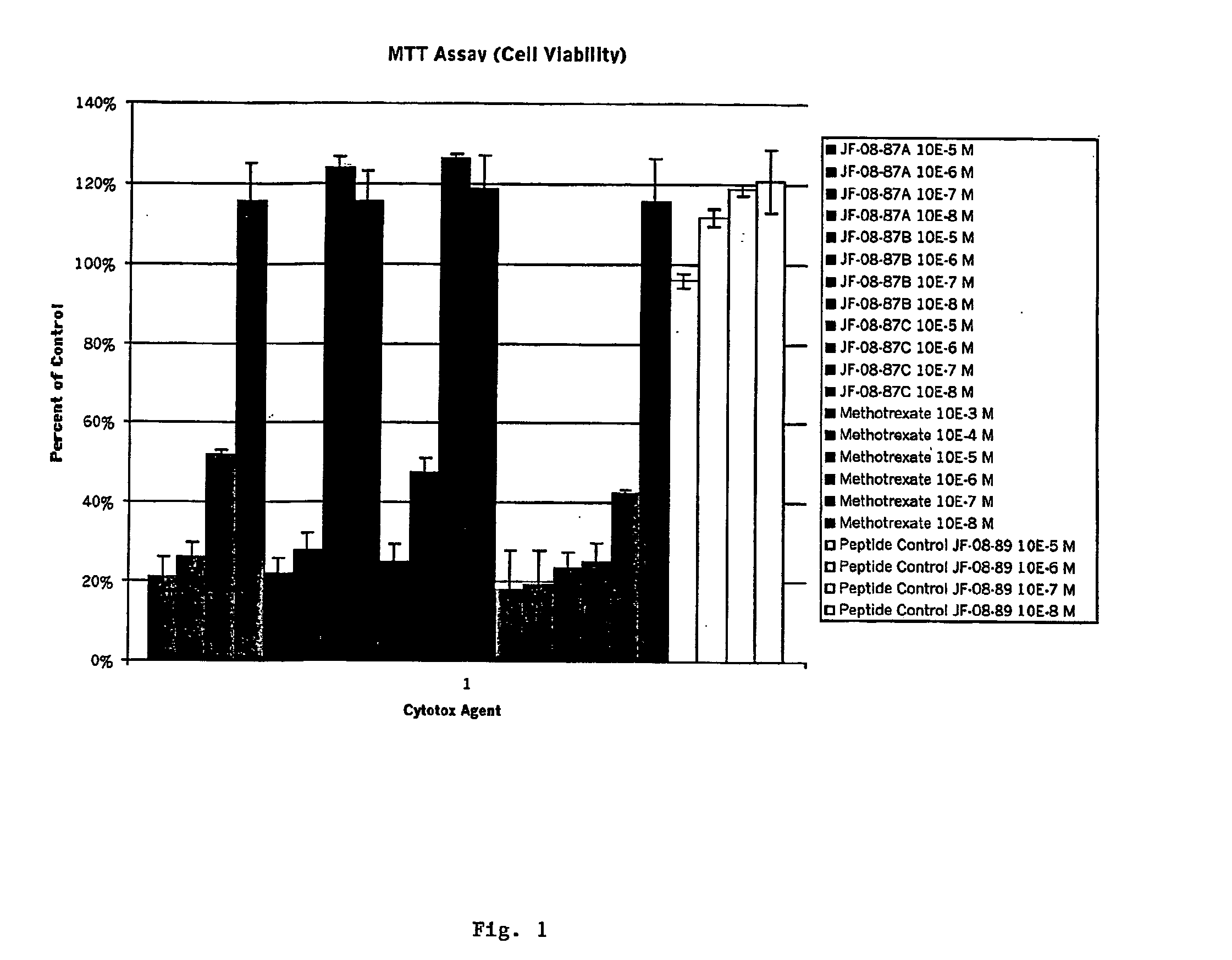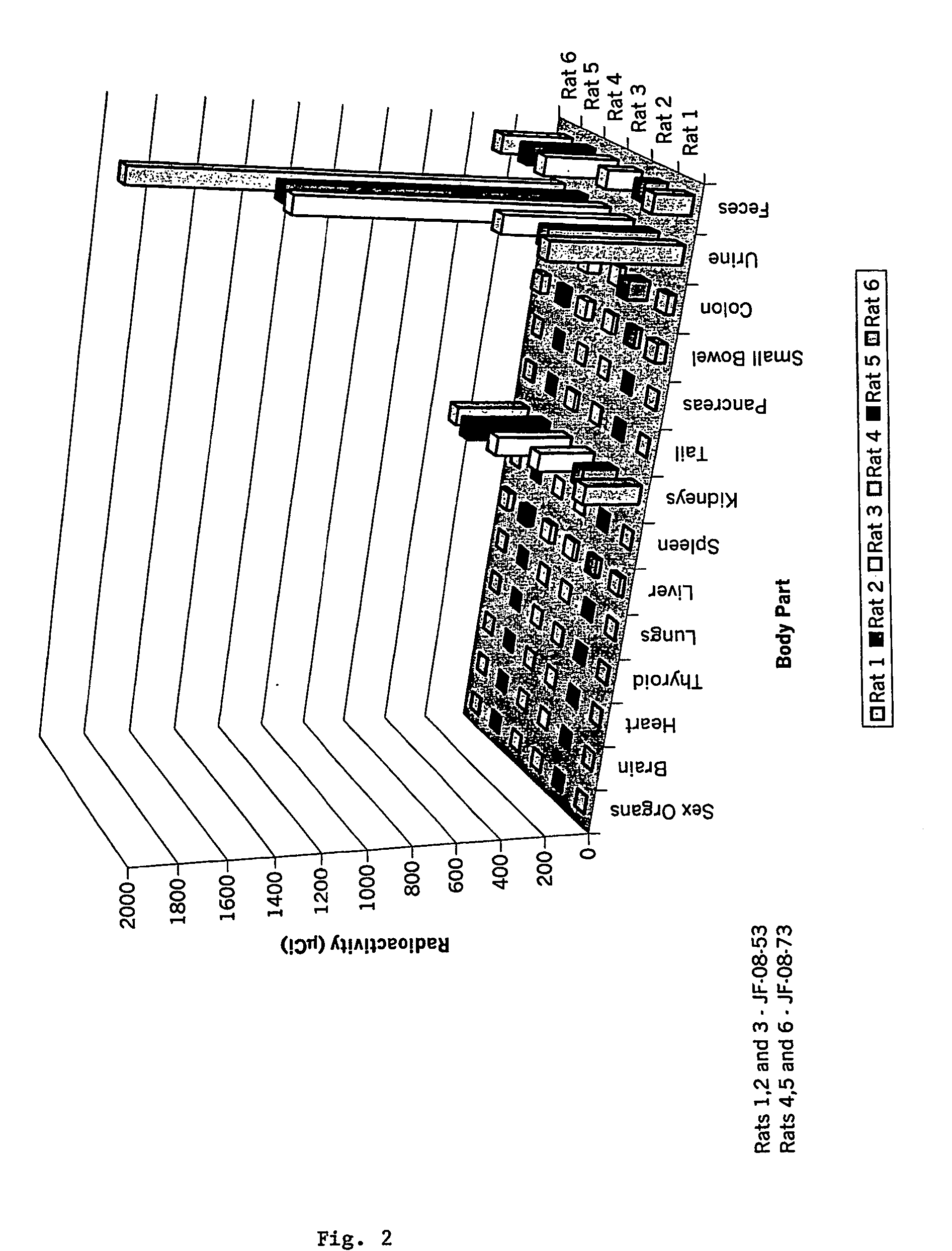Diagnostic or therapeutic somatostatin or bombesin analog conjugates and uses thereof
a technology of somatostatin and bombesin, which is applied in the direction of peptides, cardiovascular disorders, drug compositions, etc., can solve the problems of limiting the amount of agent that may be administered to a patient, reducing the maximum therapeutic dose available for this group of chemotherapeutic agents, and limiting the dose that may be delivered to the target tissue. , to achieve the effect of reducing potential drug toxicities, reducing the amount of agent administered to the patien
- Summary
- Abstract
- Description
- Claims
- Application Information
AI Technical Summary
Benefits of technology
Problems solved by technology
Method used
Image
Examples
example 2
[0090] Preparation of 2-bromo-acetyl-D-tert-butyl-Ser-D-tert-butyl-Ser-D-t-ert-butyl-Ser-D -tert-butyl-Ser-D-tert-butyl-Ser-epsilon-tert-butyloxycarb-onyl-Lys-D-tert-butyl-Tyr -D-tert-butyl-Tyr-S-trityl-Cys-Phe-D-Trp-epsilon--tert-butyloxycarbonyl-Lys-tert-butyl-Thr-S-trityl-Cys-tert-butyl-Thr-Rink--amide-resin (SEQ ID NO: 24).
[0091] Rink amide MBHA polystyrene resin (0.25 mmole) [4-(2',4'-dimethoxyphenyl-Fmoc-(aminomethyl)phenoxyacetamido-norleucyl-me-thylbenzhydrylamine resin, 100-200 mesh, Novabiochem, San Diego, Calif.] was added to the reaction vessel of a CS136 automatic peptide synthesizer (CS Bio, Inc., San Carlos, Calif.) and swollen in DMF for approximately 1 hour. The resin was filtered and an excess of 20% piperidine in DMF was added and mixed for 2 minutes. The resin was filtered and again an excess amount of 20% piperidine added and mixed for 20 minutes to ensure complete removal of the resin Fmoc group. After deprotection, the resin was washed 4 times with DMF and the...
example 3
[0093] Preparation of methotrexate-acetyl-D-tert-butyl-Ser-D-tert-butyl-Se-r-D-tert-butyl-Ser -D-tert-butyl-Ser-D-tert-butyl-Ser-epsilon-tert-butylox-ycarbonyl-Lys-D-tert-butyl -Tyr-D-tert-butyl-Tyr-S-trityl-Cys-Phe-D-Trp-ep-silon-tert-butyloxycarbonyl-Lys-tert-butyl-Thr-S-trityl-Cys-tert-butyl-Thr--Rink-amide-resin (SEQ ID NO: 24).
[0094] The di-cesium salt of methotrexate (0.75 mmol) prepared in Example 1 was dissolved in DMSO and added to peptidyl resin (0.25 mmol) prepared in Example 2 in a round bottom flask. The suspension was gently mixed while heating in a water bath (40.degree. C., 18 h), filtered, and washed with copious amounts of DMF followed by methanol. After a final filtration the derivatized resin was air dried overnight.
example 4
[0095] Preparation of methotrexate-acetyl -D-Ser-D-Ser-D-Ser-D-Ser-D-Ser-L-ys-D-Tyr-D-Tyr-cyclo[Cys-Phe-D-Trp-Lys-Thr-Cys]-Thr-amide (SEQ ID NO: 26).
[0096] The methotrexate-peptide resin prepared in Example 3 (0.25 mmol) was placed in a round bottomed flask to which was added 15 ml of a solution of trifluoroacetic acid (TFA) containing water (2.5%), 1 ,2-ethanedithiol (2.5%), and triisopropylsilane (1%). The suspension was agitated (2 h), filtered, and washed several times with TFA. The TFA was evaporated in vacuo and ether added to the resulting oil to give a yellow powder which was then dissolved in 60% acetic acid (250 ml). A concentrated solution of iodine in methanol was added dropwise with vigorous stirring until a permanent brown coloration was formed whereupon excess iodine was removed by addition of a small quantity of ascorbic acid.
[0097] The solution was reduced to a volume of around 10 ml in vacuo and the crude methotrexate peptide purified by preparative reverse phase h...
PUM
| Property | Measurement | Unit |
|---|---|---|
| Fraction | aaaaa | aaaaa |
| Electric potential / voltage | aaaaa | aaaaa |
| Hydrophilicity | aaaaa | aaaaa |
Abstract
Description
Claims
Application Information
 Login to View More
Login to View More - R&D
- Intellectual Property
- Life Sciences
- Materials
- Tech Scout
- Unparalleled Data Quality
- Higher Quality Content
- 60% Fewer Hallucinations
Browse by: Latest US Patents, China's latest patents, Technical Efficacy Thesaurus, Application Domain, Technology Topic, Popular Technical Reports.
© 2025 PatSnap. All rights reserved.Legal|Privacy policy|Modern Slavery Act Transparency Statement|Sitemap|About US| Contact US: help@patsnap.com


